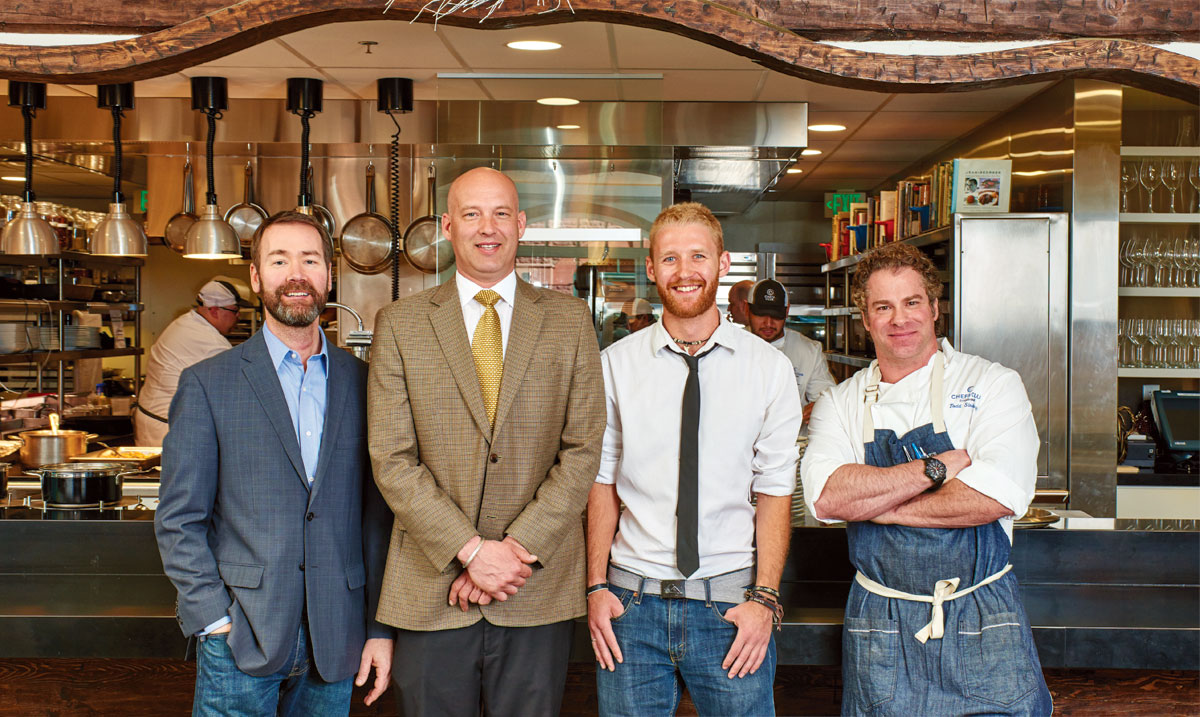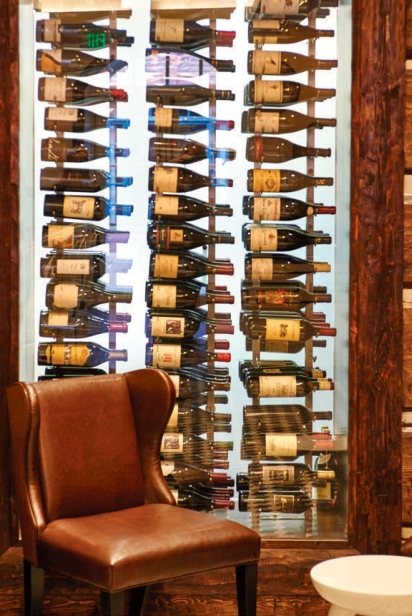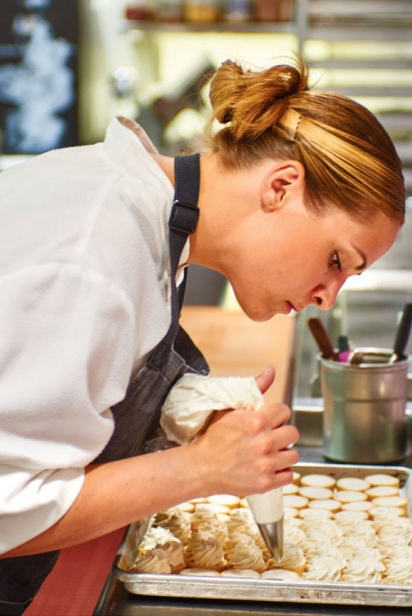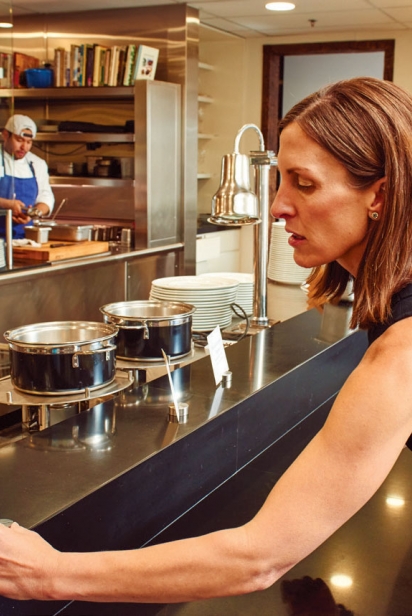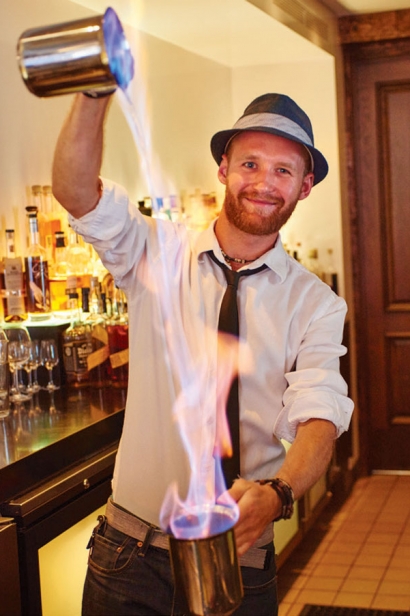Celebrating Three Years of Chefs Club
As the brand goes national, the restaurant in Aspen stays connected with local foods and management
Despite the enigmatic name, Chefs Club is a restaurant located in the St. Regis Aspen. When it opened during the celebratory madness surrounding the 30th Food & Wine Classic in June 2012, it was a truly original creation, a first of its kind worldwide. Now, Chefs Club is poised to become a global brand at the cutting-edge intersection of technology and gastronomy.
The Chefs Club concept is perhaps best described as a longterm pop-up, where carefully curated dishes from four Food & Wine Best New Chefs honorees are featured for one year. In addition to sharing menus, each guest chef shares his or her time, traveling to Aspen to cook in-house for special dinners during the summer and winter seasons. To round things out, Executive Chef Todd Slossberg contributes to the menu, which changes frequently to reflect our region’s growing season.
Chefs Club provides an opportunity for guests to dine on cuisine otherwise unavailable in Aspen, but that’s just part of a larger picture that Slossberg describes as offering “an opportunity for guests, local chefs, our staff and growers to be exposed to a diverse array of cuisines, cultures, ingredients and techniques.”
As a destination restaurant, Chefs Club’s aesthetic makes it clear you’re in a ski town. It reflects what Executive Beverage Director Anthony Bohlinger describes as “quintessential Winter Wonderland.” The whimsical, white 99-seat dining room (there’s also a 24-seat patio) has a mod ski chalet vibe (large, yet subtle, snowflakes on the ceiling, fireplace, smattering of wooden communal tables amidst the linen-draped two- and four-tops). There are white, curlicue-backed communal chairs and barstools, and a long, low dining bar front-and-center to the kitchen. The small bar area has a handful of seats and cozy banquettes, where diners can nosh from an abbreviated menu.
What’s required of a chef to succeed at Chefs Club Aspen? A willingness to: collaborate with people who may have wildly different aesthetics and ethos. Entrust that your food will be successfully executed when you’re not present by a staff that’s not your own. Work with unfamiliar ingredients in a logistically challenging climate. All of this must take place while maintaining your own restaurant’s operations.
The nationally acclaimed bar program is designed to work in tandem with the menu by utilizing seasonal ingredients and local products. And the foods are paired with wines by Master Sommelier Jonathan Pullis, who is also the CEO of Chefs Club Aspen, and Corey Campbell, the restaurant’s general manager and sommelier. Campbell has a longtime presence in Aspen’s restaurant and entertainment scene including Gisella, Campo de Fiori, Belly Up Aspen and Four Dogs Fine Wine & Spirits.
“I think the local connection we have with Todd, who has been cooking in Aspen for more than 20 years, and Corey, who’s been here just about as long, really makes Chefs Club work for both our visiting chefs and our customers,” says Pullis, who spent 15 years at The Little Nell, first as wine director and then as master sommelier, before joining Chefs Club.
Three years in, Chefs Club Aspen, as it is now called, has gone from being an experiment to a destination restaurant. Last November, the long-awaited flagship location of Chefs Club opened in Manhattan, officially making it a national brand.
“It makes sense to put a restaurant in New York—that’s the real test and a great opportunity for the up-and-coming Best New Chefs,” says Pullis.
The New York restaurant opened under the leadership of Dana Cowin, editor-in-chief of Food & Wine, and Stephane De Baets, co-owner and president of Chefs Club USA. The menu is overseen by Chefs Club Culinary Director Didier Elena, who was the first executive chef at Chefs Club Aspen. They have more yet-to-be-disclosed locations in the works, as well.
“We would love to grow the brand nationally and internationally,” says Pullis. “There are enough Best New Chefs and foodie cities in the world.”
CHEFS CLUB
Goes to New York
The much-anticipated flagship location of Chefs Club opened in Nolita last November. Located in the historic Puck Building, it followed the lead of the Aspen location, offering signature dishes from a rotating roster of four former Best New Chefs, so declared by Food & Wine magazine.
The interior, however, has a distinct NYC state of mind. Featuring custom installations by designer Murray Moss, it has been described as an “industrial meets earthy” vibe. Exposed brick walls and ceiling panels; Doric pillars painted the color of asphalt; a slate-grey and black palette; mod track lighting and burnished hardwood flooring; marble countertop seating before the open kitchen (itself stunning, with hand-tiled blue walls with hues from robin’s egg to deepest marine). There’s no question the 75-seat space is decidedly NYC. But that’s not the only difference.
It was critical the flagship have an identity of its own, separate from Aspen. Says Chefs Club Beverage Director Anthony Bohlinger, “Here, the Best New Chefs don’t take over the restaurant; instead, we have our regular menu and main dining room, and a separate Chefs Club Studio where visiting chefs from all over the world prepare tasting menus in front of diners while narrating the story behind the dishes.
Evolution of Chefs Club
Recently, I sat down with Slossberg to discuss how Chefs Club has evolved since its debut. He provided a glimpse into how technology, locality and our constantly evolving national culinary climate have positioned the brand as a high-powered platform that can help change the way diners think about food and drink.
“We want the chefs to be true to their food, but it also needs to work for Aspen,” he explains. “At first, we rotated guest chefs every three months but that didn’t lend itself to menu consistency. I like that we now feature just four chefs for a full year—it gives them an opportunity to work in two dramatically different [growing and tourist] seasons.”
It takes a special executive chef to take a backseat role to younger, up-and-coming chefs. When I mention this, Slossberg laughs. “I’m 47. My need to do something my way is gone. My style has also changed as I’ve gotten older. Now, I strive for simpler, cleaner, solid technique over fussy food—I’m not really into bubbles and foam. That said, a key part of my job is to be a good guardian of our guest chefs’ food, and it’s a melting pot of styles and methodology.”
That’s exactly the allure of Chefs Club. Nowhere else in Aspen—and until recently nowhere else in the world—can you get such a deftly executed menu so diverse in nature.
A restaurant for the digital era
“The Chefs Club menu will always have a certain disjointed feel, given all of the different influences and styles the chefs bring to the restaurant,” says Slossberg. Advances in technology, sourcing and tourism infrastructure mean chefs (and customers) are well-traveled and have greater access to a global pantry. Part of his role, then, is to ensure menus form a harmonious whole.
With the exception of special prixfixe dinners held during guest chefs’ weekends in-house, the Chefs Club Aspen menu is a la carte. This past winter, featured dishes included Nantucket Bay Scallop Crudo with Ancho Chile Purée, Sweet Potato Chips and Lime Salt ( Jason Vincent, formerly of Nightwood, Chicago), Korean-Style Braised Lamb and Dduk (rice cakes) (Chris Shepherd, Underbelly, Houston) and Poached and Grilled Venison Loin with Freekeh, Salsify Purée, Mastic Cream and Mahleb-Beet Jus (Matthew Gaudet, West Bridge, Cambridge). Ethnically, regionally and technically diverse, yes, but harmonious even as a coursed meal.
CHEFS CLUB
MIXOLOGY
The bar program at Chefs Club Aspen was established by mixologist Jim Meehan of New York’s PDT. Anthony Bohlinger took over in late 2013, and after just one year behind the bar the prodigal mixologist had made a national name for himself, thanks to his creativity in reworking classic cocktails and utilizing housemade seasonal syrups, infusions and bitters. Bohlinger was named executive beverage director and relocated back to New York last August to run the flagship.
Mattias Horseman now supervises the Aspen bar program. A convivial young Brit, Horseman has introduced a playful aspect to the menu with molecular-driven methodology, from house-made “potions” and powdered acids (think malic and citric, not hallucinatory), exotic ingredients (passionflower, yohimbe—a purported aphrodisiac derived from the bark of an African tree—and tea varietals) and a penchant for pyrotechnics.
Chef selection
Another aspect of Slossberg’s job is to help with final guest chef selection. Food & Wine chooses eight finalists, Slossberg explains, and then, “Didier and I visit their restaurants, spend time in their kitchens to see how they work, and determine if their food and personalities will translate to the Chefs Club concept.”
Once the final four are chosen, Slossberg prepares them for Aspen with information on local ingredients from producers like Avalanche Cheese Company, Emma Farms Cattle Company, Crystal River Meats, Hillside Acres and Rendezvous Organic Farm, among others—and on what specialized equipment is available in the Chefs Club kitchen.
“Cooking in an unfamiliar place with new ingredients, at altitude, can be tough, and what our guests want to eat after a day of skiing, hiking or biking isn’t necessarily what the chefs would have in mind,” he says. “I make diplomatic suggestions when needed.”
Slossberg mentions guest chefs who’ve arrived in Aspen and had dishes fail technically, despite working perfectly at their own establishments. He chuckles. “They’ll make it, then make it again and inevitably blame the altitude. But, once they call their souschefs, it will turn out they’ve tweaked the recipe for one reason or another. The smart ones bring their sous-chefs with them!”
Anecdotes aside, despite the odd mishap—fish deliveries waylaid by a blizzard, visiting chefs with altitude sickness—Chefs Club has been a smooth ride. Part of that is a result of the careful vetting process, but much is Slossberg himself. He was tapped by culinary director Elena in part because of his extensive experience working with Best New Chefs during the Food & Wine Classic from his days as executive chef at the Aspen Meadows Resort and Hotel Jerome, where he was in charge for 17 years.
Slossberg accepted the position at Chefs Club because he saw it as an “opportunity to work with all of these great chefs and continue my own education.”
And that, in essence, is what Chefs Club is all about. Says Fruition restaurant owner and chef Alex Seidel of his experience as a guest chef during the opening weekend, “If I had to say Chefs Club is about anything it’s collaboration, but I also gained three new friends out of the experience.”
GO FIND IT!
Chefs Club by Food & Wine
The St. Regis
315 E. Dean St., Aspen
970.429.9581
ChefsClub.com


